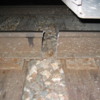We’re rolling eastbound out of Jefferson City, MO, approaching the Control Point CPM091 at Morrison, MO. mile post 91. Signal displays a restricting, (Flashing red). We had the proper signals in advance, Advance Approach,(reduce speed to 40mph), Approach, (reduce speed to 30mph prepared to stop at next signal).
So, with a 6900foot, 15000 ton grain train we proceed past the Restricting Signal doing about 8mph.
The definition of Restricted Speed:
“When required to move at restricted speed, movement must be made a speed that allows stopping within half the range of vision short of:
Train, Engine, Railroad Car, Men or Equipment fouling the track, Stop signal or Derail or switch lined improperly.
When a train or engine is required to move at Restricted Speed, the crew must keep a lookout for broken rail and not exceed 20MPH.
Comply with these requirements until leading wheels reach a point where movement at Restricted Speed is no longer required”
At mile post 89.4, don't really see a broken rail, I but feel the clucking as each axle rolls over the break. Stop the train. Walk back past the 4 units and 2 head car and there's the break, about a 1 inch gap. Its 1:55AM, report to the dispatch and instructions are to stay put and they call out the track crew. After a long 3 1/2 hour wait and getting runaround by numerous eastbounds, including the circus train heading for St. Louis and a number of westbounds, the track crew arrives. After discussion with the dispatch, the M/W foreman is told that he, (dispatcher), will hold the trains from moving on Main 1 so they can watch us roll over the broken rail on Main 2. Were finally told to take them ahead at walking speed. Only another 6500 feet to pull over the break. So, after 6 AM we are moving on down the road.
Notice the rule does not require stopping short of a broken rail. They are very hard to spot on a moving train. I would venture to guess that 80 to 90% are not seen by the crew. Most of the time they are straight breaks and trains will roll right on down the road without seeing it. Usually, a signalman will be called for signal problems and will they will find the break. Sometimes the break will still be touching causing the signals to display a Clear indication and a train will roll at 40-50-or 60MPH over the bad rail. I did that years ago, loaded coal train at 50MPH, first 50 cars made it over then boom, next 28 in a pile and many more that were scrapped because sides bulged out.
It was my conductors second week on the job and his first broken rail, so he took an interest in seeing it.
Dan
Here's the break: looks like there was a void of some sort in the head of the rail. The yellow paint may mean that the rail was ultrasound tested at some time, maybe recently and the rail was scheduled to be replaced.








